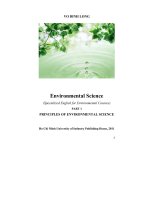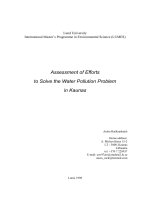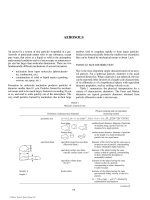Environmental Science Forest
Bạn đang xem bản rút gọn của tài liệu. Xem và tải ngay bản đầy đủ của tài liệu tại đây (1.36 MB, 15 trang )
Group 1: Forest Resources
1. Overview of forest resources
- Forest is one of the most important part constituting the biosphere
- Important role in creating the landscape and have a strong impact to the climate factors,
land. Standpoint theory of ecosystems, the forest are seen as a typical ecosystems in the
biosphere (Temslay, 1935: Vili, 1957; Odum, 1966). In the other hand, Based on the theory of
the forest of Morodov Sukasov, the forest are a Biogeocenose. Two theories are not different in
the nature. They are recognized and used in research of the forest
- Forests are also of great significance in the development of economic, social, ecological
and environmental.
- The formation of forest types are closely related to the formation of natural vegetation
with geographic and climatic conditions. In each forest type is formed, the climate, soil,
moisture will determine the composition and structure of the potential development of
vegetation.
The division of the forest types of forest vegetation types are mainly based on the
ecological advantages.
Some flora is important in the world
• Temperate coniferous forests with a relatively homogenous, lower yields than the
tropics, they are mainly distributed in North America, Europe, North China and some
tropical mountains. The trees are mainly pine, spruce, fir
•
•
Temperate deciduous forest is distributed at low and tropical regions, mainly in
northeast America, South America, Asia Europe, a part of China, Japan, Australia
Tropical rain forests are distributed mainly in the equatorial region of the Amazon Basin
(South America), the Congo River (Africa), India, Malaysia. Because of the complexity of
changing rainfall patterns, monsoon and temperature, the tropical forest are often very
complex in both composition and structure of forest
Based on the nature and purpose, the forest is divided into three types
K55 Tiên Tiến Khoa học Môi Trường
1
Group 1: Forest Resources
Protection forests are used for the purpose of protecting water, soil, prevent erosion
and mitigate natural disasters, climate regulation, protection of ecological environment.
Protection forest divided into three types, watershed protection forests, forest
protection against sand and forest protection of coastal waves
• Special use forests are used for special purposes such as nature conservation, genetic
conservation of forest flora and fauna, in service of scientific research, protection of
historical, cultural and scenic for tourism. It includes national parks, nature reserves,
cultural and historical sites
• Production forests, including forest type used for wood production, forest animals and
associated ecological environment protection.
Forest resources are plentiful and diverse, including biological resources, land, climate and
landscape. The exploitation and utilization of forest resources in the world depends on
technology, traditions and social customs of each region and each country.
Wood used as fuel, construction materials and raw materials for different industries: paper,
plastic, paint. Wood is considered the first material of chemical industry.
Forests is an important resource, forests provide raw materials for human and base
economic resources of many ethnic in the world. Exploitation of forest resources has
contributed an important part in economic and social development of many countries around
the world.
•
2. The importance of forests for environment
- Forests are the most important component constituting Biosphere. In addition to
significant plant and animal resources , the forest is also a geographical factor which is
essential in nature, it plays vitally important role in the landscape and have strong impact to
the land climate factors. Therefore,it is not only has the function of forests in economic
development, social but also of special significance in environmental protection 1. Forests
are the obstacles to the transport of wind and affect speed and direction of wind. In
general, if h is the height of the forest range, the incidence of forests to reduce wind
speed significantly within 50-10 h in direct side and 20 - 30h in indirect side
2.1) Forest not only blocks wind but also cleans the air and have a great influence on
carbon cycle in nature.
In fact, the forest is considered as a giant dust refinery.
Annually 1 ha of forests absorbs 36.4 tons of dust from the air.
- Several research also showed that, the radioactivity in water in the place where the are
forest only equal a half in the place have no forest
K55 Tiên Tiến Khoa học Môi Trường
2
Group 1: Forest Resources
Pic.Schematic diagram of carbon cycle in a forest. The processes drawn with red arrows lead
major isotopic fractionation
2.2) . Forests also contribute significantly reduces noise
For example a 50 m wide strip of trees beside the road has the potential to reduce noise 20
-30 dB
2.4 .Forest has special meaning to the importance of balance oxygen and carbon dioxide
in the atmosphere
Every year about 100 billion tons of CO2 fixed during photosynthesis by plants and a similar
amount is returned to the atmosphere by various processes in nature
. It is predicted that if the whole biomass of tropical rain forest were burned in the next 50
years, and the amount of CO2 generated is not replaced by other sources to absorb CO2 is
released at a rate of twice the current today.
. if the rate of deforestation maintain by 2050, the atmospheric concentration of cacbon
dioxide will doubled compared with the current and temperature of the Earth will increase by
about 2 degree. At that moment the ice will melt make the sea level rise as high as 3m by the
end of XXI century.
2.5 ). Phenomenon of evaporation from plant biological effects of climate create rain clouds
The amount of water released from the plant is huge and depending on soil moisture. In
Sweden, from 1 ha of spruce forests on dry land out of water about 2100m3 /year , equivalent
to a rainfall of 210 mm, while 1 ha of forest on soil moisture will exit near 4000m3/year ,
equivalent to 400mm. Overall, the amount of water vapor from the coniferous forest plants
average 2-3 tons / ha / year, also in evergreen forests may reach 4-6 tons / ha / year. Material
evaporation occurs under the forest canopy is much less than bare ground, usually only 100
tonnes / ha / year in European forests
.Forest created a sub-climate environment well to human health. Forests reduces the
temperature and increases humidity. Especially many species can secrete substances with
bactericidal action phitoxin special pine (Pinus sp), camphor (camphora cinamonmun),
eucalyptus (Eucalyptus), cinnamon (cassia Cinnamonmun)
K55 Tiên Tiến Khoa học Môi Trường
3
Group 1: Forest Resources
Forest with the role of watershed protection, soil protection against erosion. Vegetation have
an important function in preventing a fall to the ground and rain water has a role in the
redistribution of this water.
Studies show that plants retained 25% of the total rainfall.The canopy of forest can reduce the
power of destruction of rain with topsoil. Forests increase infiltration and water holding
capacity of soil, restricting the flow on the surface. Litter of the forest floor can hold 100-900%
of its weight. Therefore significantly reduce soil erosion.
Many studies show that in our country humid tropics, where forest soil erosion each year only
about 1 - 1.5 tons / ha in the forest where there is no up to 100-150 tons / ha and the surface
flow increased 3-4 times
3.Common causes of deforestation
Commercial logging companies cut down mature trees that have been selected for their
timber. The timber trade defends itself by saying that this method of 'selective' logging
ensures that the forest regrows naturally and in time, is once again ready for their 'safe'
logging practices (WWF).
Removing a felled tree from the forest causes even further destruction, especially when
it is carried out carelessly. It is believed that in many South East Asian countries
'between 45-74% of trees remaining after logging have been substantially damaged or
destroyed
The reason these people are referred to as 'shifted' cultivators is that most of them
people have been forced off their own land. For example, in Guatemala, rainforest land
was cleared for coffee and sugar plantations. The indigenous people had their land
stolen by government and corporations. They became 'shifted cultivators', moving into
rainforest areas of which they had no previous knowledge in order to sustain themselves
and their families (Colchester & Lohmann)
The creation of national parks has undoubtedly helped to protect rainforests. Yet, as
national parks are open to the public, tourism is damaging some of these areas.
Often, national parks are advertised to tourists before adequate management plans
have been developed and implemented. Inadequate funding is allocated for
preservation of forests by government departments. Governments see tourism as an
easy way to make money, and therefore tourism is encouraged whilst strict
management strategies are given far less government support.
4.Forest loss and management .
Anthropogenic factors that can affect forests include logging, urban sprawl, humancaused forest fires, acid rain, invasive species, and the slash and burn practices of
swidden agriculture or shiftin cultivation.
Expand the area of agricultural land to meet food production.
Demand for fuelwood .
Grazing.
K55 Tiên Tiến Khoa học Môi Trường
4
Group 1: Forest Resources
The loss and re-growth of forest leads to a distinction between two broad types of forest,
primary or old-growth forest and secondary forest. There are also many natural factors that can
cause changes in forests over time including forest fires insects, diseases, weather, competition
between species, etc. In 1997, the World Resources Institute recorded that only 20% of the
world's original forests remained in large intact tracts of undisturbed forest.More than 75% of
these intact forests lie in three countries - the Boreal forests of Russia and Canada and the
rainforest of Brazil. In 2006 this information on intact forests was updated using latest available
satellite imagery.
Canada has about 4,020,000 square kilometres (1,550,000 sq mi) of forest land. More than
90% of forest land is publicly owned and about 50% of the total forest area is allocated for
harvesting. These allocated areas are managed using the principles of sustainable forest
management, which includes extensive consultation with local stakeholders. About eight
percent of Canada’s forest is legally protected from resource development (Global Forest
Watch Canada)(Natural Resources Canada). Much more forest land — about 40 percent of the
total forest land base — is subject to varying degrees of protection through processes such as
integrated land use planning or defined management areas such as certified forests (Natural
Resources Canada)
5. The forest resources in Vietnam .
Issues of exploitation and use forests in Vietnam
Table 1. Plantation area focused 1990-2000 In Area
area
(1000
Data source: Economic
Situation - Vietnam Social
ha)
1991-2000
1990
100,3
Greatest achievements in
1991
123,9
the forestry sector
1992
122,8
achieved in recent years is
1993
128,2
the capital of forests has
1994
158,1
been maintained and
1995
209,6
developed. Total forest
1996
202,9
area based on the
1997
221,8
inventory published in
1998
208,6
2000 reached 10.9 million
1999
230,1
hectares, up 1.8 million
2000
232,3
hectares compared with
1990, the forest coverage rate has increased from 27.7% in 1990 to 32.2% in 2000 and 35.8% in
2002. The reason for such results, a work surface by new forest planting, forest regeneration,
reforestation a top priority. On the other hand, closed forest policy, forest protection and
development of forests have been seriously implementing the country. Implement the policy of
this State, the majority of forest enterprises units, households have moved from small-scale
years
K55 Tiên Tiến Khoa học Môi Trường
Index
(Previous
year 100%)
120,5
123,5
99,1
104,4
123,3
132,6
96,8
109,3
94,0
110,3
101,0
5
Group 1: Forest Resources
missions to planting, forest protection and forestry services. Logging tasks to reduce the
maximum level, the forest development. From 1990 to 2000 the country had 1939 thousand
hectares of planted forests to focus on average each year 176 thousand hectares are planted.
In the period 1990-1995 was 743 thousand hectares planted, the average annual 149 thousand
hectares in 1996-2000 planted 1096 hectares, planted 219 thousand hectares per year (see
Figure 1).
The value of forestry production in 1991-2000 the average annual increase of 1.2%. Despite
lower growth rate compared to other economic activities, but the structure of the output value
of forestry sector over the years has changed in a positive way. Production value due to
reforestation, regeneration, regeneration and protection is growing. Value of forest products
from planted forests has increased in recent years.
In about 10 years (1990-2000) production of timber country reached 29.6 million m3, the
average annual exploitation of 2.68 million m3. Closed due to forest policy has been limited
logging wood production forests should exploit recent years has fallen from 32 million in 1990
to 24 million in 2000. The exploitation of timber, firewood for necessities such as paper
materials, pit props (see Figure 2).
Table 2. Timber production 1990 - 2000
In
timber
Index
production
years
(Previous
year 100%)
(1000
tonnes
1990
3445,5
105,6
1991
3209,6
93,2
1992
2686,5
83,7
1993
2883,6
107,3
1994
2853,2
98,9
1995
2793,1
97,9
1996
2833,5
101,4
1997
2480,0
87,5
1998
2216,8
89,4
Data source: Economic Situation - Vietnam Social 19911999
2122,5
95,7
2000
2000
2050,0
96,6
forest use in Vietnam
• Improve the environment: climate control, reduce co2, forest protection, to avoid
erosion
K55 Tiên Tiến Khoa học Môi Trường
6
Group 1: Forest Resources
•
As fuel for a number of industries such as forest product processing, paper production,
furniture making ....
•
Ecotourism development: national forests, ecological reserves, biological reserves
•
For scientific research, conservation of rare plants and animals, ecosystem development
…
Causes of forest degradation in Vietnam
May yet be the main cause of deforestation and forest degradation in our country are:
- Burn shifting cultivation: nomadic life, the total area of forest lost each year is about 40 - 50%
is due to burn shifting cultivation. In Dak Lac in the period from 1991 - 1996 average loss of
3000-3500 ha of forest per year, of which over half the forest area lost due to shifting
cultivation.
- Land under the land to produce crops business, especially deforestation for the cultivation of
industrial crops such as coffee in the Central Highlands make up 40 - 50% forest loss in the
region.
K55 Tiên Tiến Khoa học Môi Trường
7
Group 1: Forest Resources
- Overexploitation beyond the natural resilience of the forest.
- Due to the impact of bombs and toxic chemicals during the war, particularly in the south have
destroyed about 2 million ha of natural forests.
K55 Tiên Tiến Khoa học Môi Trường
8
Group 1: Forest Resources
- Do not plan mining, fishing techniques obsolete waste of forest resources.
- Due to forest fires, especially mangrove forests, pine forests, deciduous dipterocarp forest.
6.Issues of exploitation and use forests in Vietnam.
1. Forest and forest lands
Statistics in Vietnam show that 19.2 million hectares are forest land of which 9.3 million
hectares are forested area, and 10 million hectares are denuded hillsides and barren lands.
Total standing volume is reported to reach 584 million cu.m. of wood and 6.3 billion of
bamboo calms. Out of 9.3 hectares of existing forests5, there are 8.3 million hectares of natural
forests and 1.05 million hectares of man-made ones, details of which follow:
K55 Tiên Tiến Khoa học Môi Trường
9
Group 1: Forest Resources
Figures assumed to apply around 1995 (Editor).
Description
Total
Forested
Non-forested
Forest land
19.1
9.3
9.7
- Special-use forest
1.2
0.9
0.3
- Protection forest
8.0
3.5
4.5
- Production forest
9.9
4.9
5.0
Besides, there exist over 1-2 billion scattered trees planted in and around home gardens,
along roadsides, canals. That asset of scattered trees is going to increase by some 300 million
trees established every year. When converted into full plantation area, scattered trees now
being established are reported to reach over 1-2 million hectares. These "outside forest"
resources are of much relevance to local farmers who can find in these plantation belts (or
patches) a lot of ready fuelwood and small timber for daily uses in the countryside. These
resources too can contribute to the lessening of the destruction of natural forests in many
areas/regions of Vietnam.
2. Forest cover in various areas/regions of Vietnam
The differences in climatic conditions from sub-equatorial areas to sub-tropical ones as
noticed in Vietnam and its elevations from sea level to mountains of over 3,000 m high, have
caused the indigenous plant and forest resources to differ in terms of tree composition, forest
types and forest cover. There are the dominance of pine forests, broad-leaved forests, mixed
coniferous stands, and even dipterocarp forests in the uplands; and the occurrence of lowland
dipterocarp forests, mangroves, bamboos, and mixed stands of hardwoods and bamboos in
lower areas, flats and wetlands. Forest resourses in Vietnam are not evenly distributed, covering
in different areas different percentage of local
K55 Tiên Tiến Khoa học Môi Trường
10
Group 1: Forest Resources
Total land mass:
Region
%
Nation-wide
28
- North West
14
- Paper raw material area (in the North)
24
- North East
20
- Red River Delta
4
- North Central Vietnam
35
- Coastal South Central Vietnam
35
- Western High Plateaux
56
- East South Vietnam
21
- Mekong Delta
5
The quality of forests varies in the same direction as their distribution in term of area, i.e.
wherever the forest cover in lower, the quality of the forest resources (their composition and
economic values as well), is also poorer.
3. Changes in forest resources and prospects in the year 2010
Looking back to the year 1943, one can find that the forest cover at that time was not less
than 43%. Satellite imageries obtained in 1973 thaw that the forest area amounted then to 9.5
million hectares, accounting for a cover of 29%. Statistics from the years 1981 and 1982, gained
through the interpretation of photos from Landsat in 1979-1981 and from KATE 140 during the
same period, show that the forested area was then 7.8 million hectares covering 28% of total
land. The forested area in 1995 and the forest cover during the same year look almost the same
K55 Tiên Tiến Khoa học Môi Trường
11
Group 1: Forest Resources
as in 1989.
It is difficult to say that there are some real increases in the area of existing forests from
1980 to now, because before that year, forests were so rated when they got a standing volume
of more than 28 cu.m. per hectare that criterion since then has changed and has become not
applicable in the following year statistics.
However, the fact is that the forest area has shrunk, on the average at a rate of hundred
thousands of hectares per year because of clearing for food production, shifting cultivation, of
wild fires and careless wood and timber extraction, leading not only to losses in forest area but
also to the degradation of forest resource with tree composition, precious genes and stand
volume, are going to decline dramatically.
More recently, as due attention by the Government and consent by local farmers have been
gained in forest management, the area of man-made forests has increases step by step from
625,000 hectares on 1989 to 1,049,700 hectares in 1995, at a rate of 125,000 hectares of
plantation in 1991 being increased to 235,000 hectares of same in 1996. With the eventual ban
on wood and timber extraction from natural forests and strong emphasis on forest plantation,
protection, regeneration and restoration, it is to be hoped that in the year 2010, the state of
forests of Vietnam will lock different with:
•
A system of protection forests of over 8 million hectares being crested, in particular for
the protection of the watershed areas of big rivers and water reservoirs for navigation
and for hydroelectric power generation for the country as a whole, the protection of an
extensive area along the coast and of farm crops cultivated at the foot of denuded
hillsides and barren lands in the Deltas.
•
A system of special-use forests covering 1-1.2 million hectares of natural forests mainly,
in which one can find a number of National Parks, Protected Areas, and Historic Sites
being well managed for public welfare and cultural conservation.
•
A system of production forests extending over 10 million hectares, of which after the
year 2000 industrial (or commercial) forest plantations will play a key role, while natural
forests there will be exploited at only a moderate rate. It is also planned to manage
intensively at least 5 million hectares of production forests giving high yield and
products of high quality to industries. The final outcome will be an effective
management of all three (3) categories if forests providing a cover of not less than 40 %
of the total land mass on which the area of denuded hillsides and barren lands will be
kept to a minimum.
K55 Tiên Tiến Khoa học Môi Trường
12
Group 1: Forest Resources
TTable 1. Regional variations forest cover (2005)
Regional
(%)
Forest cover
Red River Delta
8.4
Northeast
45.4
Northwest
37.8
Northern Central Coast
46.7
Southern Central Coast
38.1
Central Highlands
54.8
Southeast
26.0
Mekong River Delta
7.9
Whole country
36.66
K55 Tiên Tiến Khoa học Môi Trường
13
Group 1: Forest Resources
Table 2. Forest land in Viet Nam (2004)
Forest types
Total area
(ha)
Production
forest (ha)
Protection
forest (ha)
Special-use
forest (ha)
I. Forested area
12 306 858
4 465 717
5 920 688
1 920 453
A. Natural forest
10 088 288
3 145 251
5 105 961
1 837 076
B. Plantation forest
2 218 570
1 320 466
814 726
83 378
II. Non-forested forest
area
6 718 576
2 529 807
3 709 440
479 328
19 025 434
6 995 525
9 630 128
2 399 782
Total
Forest area in Viet Nam has changed significantly in recent decades (Figure 1). Total forest
cover dropped from 43.3 percent in 1943 to 33.8 percent in 1976 and 27.8 percent by 1990. In
absolute terms, almost 2 million hectares of forest were lost between 1976 and 1990; a net
deforestation rate of over 142 000 hectares per year. A turning point came in 1995 when forest
area increase exceeded forest loss (mostly due to new plantations), and overall forest cover
increased from 28.2 percent in 1995 to 36.7 percent in 2004.
Figure 1. Changes in forest area in Viet Nam over time
In 1943 the forest area of Vietnam was estimated to be about 14.3 million hectares, or 43%
of the total land area. Owing to long-lasting wars, shifting cultivation, land clearances and
over-exploitation, forest coverage was reduced at a rate of about 100,000 ha each year to
27.1% in 1980 and 26.2% in 1985 (Ministry of Forestry 1991). At present, total forest land is
K55 Tiên Tiến Khoa học Môi Trường
14
Group 1: Forest Resources
about 16 million ha which occupies 48.3% o0f the country's total land area. By the end of 1999,
statistical data relating to forest can be seen as follows,
Total forest area : 10,915,592 ha (forest coverage: 33.2%)
Natural forest : 9,444,198 ha (occupies 86.5% of forest area)
Protection forest : 4,812,671 ha,
Special-use forest : 1,463,746 ha,
Production forest : 3,167,781 ha.
Plantation forest : 1,471,394 ha (occupies 13.5% of forest area)
Protection forest : 537,997 ha,
Special-use forest : 61,122 ha,
Production forest : 872,275 ha
*****
The end *****
K55 Tiên Tiến Khoa học Môi Trường
15









